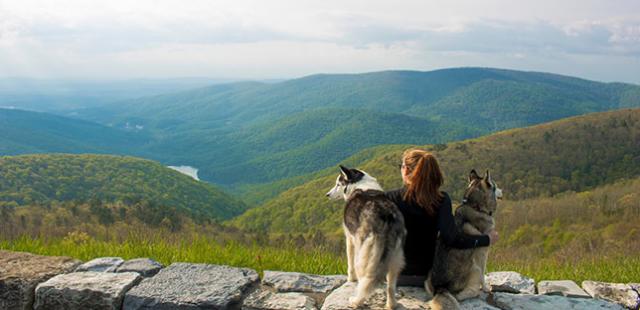Science and Natural History Museums
Virginia's Science and Nature Museums explore the impact of science on our lives. Check out everchanging, hands-on exhibits that explain areas of study from astronomy to zoology.
The Danville Science Center features many permanent exhibits, such as Light and Vision, Earth Science and Music Making in the Outdoor Sound Exhibit. Be sure to see the Butterfly Station, too.
Virginia Museum of Natural History is an affiliate of the Smithsonian Institution and houses more than 22 million objects in its collection.
Museum of Geological Sciences at Virginia Tech features dinosaur footprints, a full-scale dinosaur and other fossils.
The Museum of the Middle Appalachians includes the unique geology of the region. See full-size replicas of Ice Age mammals that once roamed the area 15,000 years ago. Annual archeological and paleontological digs at the site have gleaned artifacts and fossils.
The North Anna Information Center shows how nuclear energy is important with informative tours or self-guided tours at your own pace. Learn about the mining of uranium to producing electricity with it. Test your knowledge on electricity, generate your own muscle power and view a model nuclear reactor.
Chimborazo Medical Museum was the actual destination for thousands of wounded Confederate soldiers. See a collection of equipment used by the doctors and nurses, watch a 17-minute film and view a diorama of the hospital during that time.
The Lora Robins Gallery at the University of Richmond features collections of gems, jewelry, minerals, fossils and fabulous seashells in scientific groupings. Displays relate to natural history of various countries and cultures.
Maymont Nature and Visitor Center features a 20-foot waterfall and 13 huge aquariums full of delightful otters, fish and turtles from Virginia's rivers. Children especially enjoy the antics of the otters as well as the Children's Farm.
The Science Museum of Virginia features hundreds of permanent and visiting exhibits from astronomy to computers, flight to crystals, DNA to electricity. For example, play laser pool, see how the Faucault pendulum proves the Earth's rotation, and visit the museum's Ethyl Corporation IMAX® & Planetarium.
Virginia Aviation Museum features 30 historic aircraft, including airworthy Wright Brothers reproductions and Admiral Richard E. Byrd's' plane that he flew to Antarctica. Enjoy various aviation films and see a real SR-71 on permanent display!
The NASA Visitor Center at Wallops Flight Facility features everything from an exhibit hall to an observation deck, informative videos and family activities. This working facility launches sounding rockets, scientific balloons and performs aircraft research. Advance reservations are required for tours. The year-around Virginia Space Flight Adventure Camp is a popular program for future scientists ages 12-15.
The Alexandria Archaeology Museum showcases archeologists at work reconstructing the city's history, fragment by fragment. See artifacts from recent digs. Special events include the popular Family Dig Day every summer.
The National Air and Space Museum, Steven F. Udvar-Hazy Center is an extension of the Smithsonian's National Air and Space Museum in Washington, D.C. See important icons of aviation and space history. Visitors can watch air traffic at Dulles from an observation tower. Flight simulators and an IMAX® Theater are other
The D. Ralph Hostetter Museum includes anthropology artifacts, fossils, marine life, minerals, crystals and gems. Other displays include mounted American and African game, birds and special exhibits.
JMU Meteorite Collection is in the John C. Wells Planetarium Hallway of Miller Hall at James Madison University. See fragments of meteoroids that survived passage through the atmosphere to land at places in the Sahara Desert and Arizona.
The Science Museum of Western Virginia invites you to explore the wonders of science through hands-on experiences, such as at the weather gallery, science arcade and Body Tech, which explores the mechanics of the human body. Be sure to visit the Hopkins Planetarium and the MegaDome Theater, too.
The Chesapeake Planetarium features a new topic each month. Reservations are required.
The Virginia Air & Space Center is located in the Birthplace of America's Space Program and the official visitor center for NASA Langley Research Center. Launch a rocket, pilot a shuttle and come face-to-face with the Apollo 12 Command Capsule that went to the moon. See a moon rock, a Mars meteorite and historic planes. There's also an IMAX® Theater. Be sure to see the Virginia Air & Space Center's Adventure in Flight Gallery.
The Virginia Living Museum features animals native to Virginia. See them in their natural habitats - a cypress swamp, cool mountain streams, underwater and under the earth in a limestone cave. Numerous hands-on discovery centers make this museum special. Travel the universe in the planetarium theatre, too.
Nauticus, The National Maritime Center features more than 150 exhibits including touch pools, exotic aquaria and computer/video interactive exhibits. The USS Wisconsin, one of the last and largest battleships built by the U.S. Navy, is berthed next door and open for tours.
Surry Nuclear Information Center explains why nuclear energy is important through guided tours and self-guided tours at your own pace. Learn about mining of uranium to producing electricity at this state-of-the-art center. Various exhibits are hands-on, too.
The Virginia Aquarium's Bay Lab at First Landing State Park is environmentally focused and is a nature-based eco-tourism center with three aquariums, environmental exhibits, a wet lab and touch tank.
The Virginia Aquarium & Marine Science Center takes visitors through Virginia's marine environment in two buildings with huge aquariums and live animal habitats. With more than 300 hands-on exhibits, plan to spend an entire day at touch tanks, at an outdoor aviary and exploring a 3-mile nature trail. The Virginia Aquarium 3D IMAX® Theater, dolphin-watching cruises and whale-watching trips are other activities offered at different times of the year.







